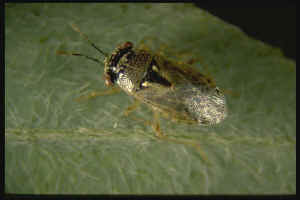|
|
BIG-EYED BUGS |
|
|
Although they are very tiny, Big-eyed bugs are mighty hunters. They eat other bugs that destroy garden plants and farm crops. Both adults and nymphs eat a variety of insect eggs including those of mites, aphids, and leafhoppers. They also stalk and eat other insect prey including caterpillars, spider mites, and flea beetles. One big-eyed bug can eat dozens of spider mites in a single day. In the garden, big-eyed bugs are attracted to potatoes, clover and green beans, and they will keep these vegetable plants safe from other bugs that would destroy the plants. Big-eyed bugs are also some of the best friends of cotton farmers in the south. Big-eyed bugs kill insect pests that destroy cotton plants such as boll weevils, bollworms, bud- worms, and beet army worms. Big-eyed bugs are important because they keep cotton crops safe from infestations of these insects. Both the males and the females are voracious killers of harmful insects from the moment they hatch until their death several months later. Big-eyed bugs live in the southern and western parts of the United States and there are several species are found in Texas. Big-eyed bugs have small oval bodies and broad heads with distinctive, large, wide-set, bulging eyes. These bugs are only about 1/4 inch long with short antennae that have enlarged tips. Adults are usually gray, brown or yellowish in color. Nymphs look similar to adults but do not have wings. The nymphs are only 1/8 inch in length. Big-eyed bugs live longer than most bugs - they usually live for three to four months. The females produce eggs for most of their life, and they average two or more eggs per day. Big-eyed bugs have a dramatically high tolerance to insecticides.
|


